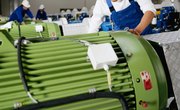
Failure rates are an important consideration in engineering. They are used to determine the reliability of a system or a component in a system. To calculate a failure rate, you need to observe the system or the component and record the time it takes to break down. As with any statistic, the more data you have, the more accurate the failure rate calculation will be. For example, if you were calculating the failure rate of a specific type of USB cable, your calculation would be more accurate if you tested 1,000 cables over a year rather than one cable over a few days.
Calculating Constant Failure Rates
In order to measure failure rates, you need a sample of identical components or systems that can be observed over time. For example, suppose you had five light bulbs connected to an automatic circuit that you could then turn on and off once per hour for 1,000 hours, giving you the following data:
- Bulb 1 burned out after 422 hours.
- Bulb 2 burned out after 744 hours
- Bulb 3 burned out after 803 hours
- Bulb 4 burned out after 678 hours
- Bulb 5 stayed lit for 1000 hours
This gives you 4 failures over a total of 3,647 hours.
To calculate the failure rate, divide the number of failures by the total number of hours, such as 4/3,647 = 0.0011 failures per hour.
In this example, the failure rate per hour is so small that it is almost insignificant. Multiplying the number by 1,000 would make it more meaningful to someone thinking about buying a light bulb, which would be 1.1 failures per 1,000 hours. Since there are 8,760 hours in one year, you can divide 3,647 by 8,760 to get 0.41 failures per year, or about 2 failures every five years.
Calculating MTBF
Another way to express failure rates is by using the Mean Time Between Failures. MTBF is usually used in high-quality systems where failures are expected to be rare and need to be minimized, like the guidance system on a commercial aircraft or the air bags in a passenger car. Knowing the MTBF allows manufacturers to recommend how often components should be inspected, maintained and replaced.
To calculate the MTBF, you divide the number of hours by the number of failures. In the case of the five light bulbs that were tested, which had a failure rate of 4 per 3,647, you determine the MTF as 3,647/4 = 909. The MTBF is therefore 909 hours.
Degrading Systems Over Time
In most real-world scenarios, the likelihood of failure increases over time as components break down and parts wear out. A car's brake system, for example, is less likely to fail in the first year of ownership than it is after five years without maintenance. As a result, it is usually necessary for engineers to test components for longer periods of time and to calculate the failure rates for different intervals.
References
About the Author
A published author and professional speaker, David Weedmark was formerly a computer science instructor at Algonquin College. He has a keen interest in science and technology and works as a technology consultant for small businesses and non-governmental organizations. A science fiction writer, David has also has written hundreds of articles on science and technology for newspapers, magazines and websites including Samsung, About.com and ItStillWorks.com
